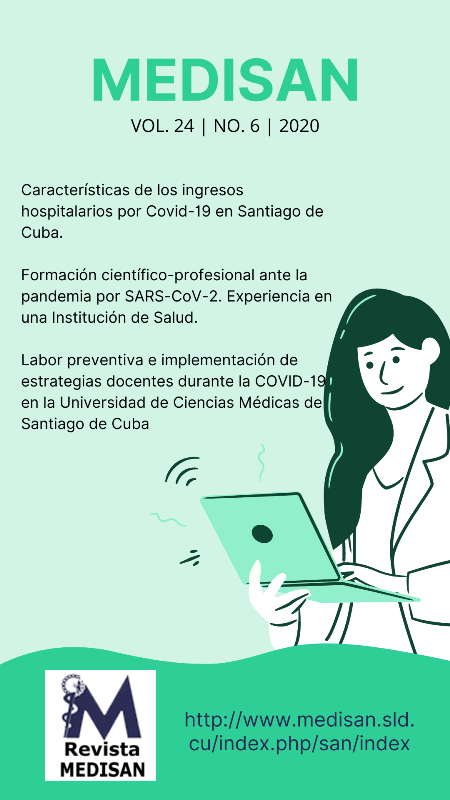Correlation of the anthropometric parameters predictors of emerging risk for diabetes mellitus
Keywords:
anthropometric warning signs, diabetes mellitus, body mass index, body fat percentage, visceral fat percentage, waist perimeter.Abstract
Introduction: There are risk anthropometric predictors parameters of suffering from diabetes mellitus that can be correlated, such as the body mass index, body fat percentage, waist perimeter and visceral fat percentage.
Objective: To establish the potential risk of suffering from type2 diabetes mellitus by means of the correlation of indicators and anthropometric measures applicable to a local population.
Methods: An epidemiological, cross-sectional, observational and analytic study of 118 young individuals was carried out in the Catholic University of Córdoba, in Córdoba, Argentina, during the month of September, 2019, in which the FINnish Diabetes Risk Score was implemented, the body fat and visceral fat percentages were also taken as warning signs. In the statistical analysis of the quantitative and qualitative variables the average and the standard deviation were used as descriptive measures; also, the Shapiro-Wilks and Kolmogorow-Smirnov normality tests and the Spearman correlation test were implemented to prove the outlined statistical hypotheses.
Results: It was found that it was a low risk population and the correlation between the body mass index and the body fat that was adjusted was Y=1.18X+4.06; where Y was the body fat percentage and X the body mass index. To correlate the waist perimeter and the visceral fat percentage Y=0,21X-10,21 for men and Y=0,17X-7,84 for women were adjusted, where Y was the visceral fat percentage and X the waist perimeter.
Conclusions: The knowledge of the population health condition leads to the training and assistance for the selfcare and to the acquisition of healthy habits that contribute to an adulthood with life quality.
Downloads
References
2. Naranjo Hernández Y. La diabetes mellitus: un reto para la Salud Pública. Rev Finlay. 2016 [citado 05/08/2020];6(1):1-2. Disponible en: http://scielo.sld.cu/scielo.php?script=sci_arttext&pid=S2221-24342016000100001&lng=es
3. Organización Mundial de la Salud. Informe Mundial sobre la diabetes. Ginebra: OMS; 2020 [citado 05/08/2020]. Disponible en: https://apps.who.int/iris/bitstream/handle/10665/204877/WHO_NMH_NVI_16.3_spa.pdf;jsessionid=F7F43691F7EC8CB46E6A27F6B255817D?sequence=1
4. Organización Mundial de la Salud; Organización Panamericana de la Salud. Acerca de Diabetes: datos y cifras, 2016. Washington, D.C.: OPS; 2016 [citado 05/08/2020]. Disponible en: https://www.paho.org/hq/index.php?option=com_content&view=category&id=4475&layout=blog&Itemid=40610&lang=es&limitstart=15
5. Domínguez-Reyes T, Quiroz-Vargas I, Salgado-Bernabé AB, Salgado-Goytia L, Muñoz-Valle JF, Parra-Rojas I. Las medidas antropométricas como indicadores predictivos de riesgo metabólico en una población mexicana. Nutr Hosp. 2017 [citado 23/07/2020];34(1):96-101. Disponible en: http://scielo.isciii.es/scielo.php?script=sci_arttext&pid=S0212-16112017000100015&lng=es&nrm=iso&tlng=es
6. Cedeño Morales R, Castellanos González M, Benet Rodríguez M, Mass Sosa L, Mora Hernández C, Parada Arias JC. Indicadores antropométricos para determinar la obesidad, y sus relaciones con el riesgo cardiometabólico. Rev Finlay. 2015 [citado 15/06/2020];5(1):12-23. Disponible en: http://scielo.sld.cu/scielo.php?script=sci_arttext&pid=S2221-24342015000100003&lng=es
7. Domínguez-Reyes T, Quiroz-Vargas I, Salgado-Bernabé AB, Salgado-Goytia L, Muñoz-Valle JF, Parra-Rojas I. Las medidas antropométricas como indicadores predictivos de riesgo metabólico en una población mexicana. Nutr Hosp. 2017 [citado 15/08/2020];34(1):96-101. Disponible en: http://scielo.isciii.es/scielo.php?script=sci_arttext&pid=S0212-16112017000100015&lng=es
8. Ascar GI, Aparicio ML, Ascar LD, Huespe CB, Hernández MM. Riesgo de diabetes mellitus de tipo 2 como indicador de desigualdad social. MEDISAN. 2018 [citado 15/06/2020];22(7). Disponible en: http://scielo.sld.cu/scielo.php?script=sci_arttext&pid=S1029-30192018000700487
9. Hernández Sandoval G, Rivera Valbuena J, Serrano Uribe R, Villalta Gómez D, Abbate León M, Acosta Núñez L, et al. Adiposidad visceral, patogenia y medición. Rev Venez Endocrinol Metab. 2017 [citado 22/07/2020];15(2):70-7. Disponible en: http://ve.scielo.org/scielo.php?script=sci_arttext&pid=S1690-31102017000200002&lng=es
10. Ascar GA, Aparicio ML, Salomón MS. Detección de riesgo de diabetes en pacientes hipertensos. Rev Cubana Farmacia. 2016 [citado 10/10/2019];50(2). Disponible en: http://www.revfarmacia.sld.cu/index.php/far/article/view/26/30
11. Quesada Leyva L, León Ramentol CC, Betancourt Bethencourt J, Nicolau Pestana E. Elementos teóricos y prácticos sobre la bioimpedancia eléctrica en salud. AMC. 2016 [citado 19/09/2019];20(5):565-78. Disponible en: http://scielo.sld.cu/scielo.php?script=sci_arttext&pid=S1025-02552016000500014
12. Salinas Méndez LE, Vargas Álvarez JE, Mendoza Sánchez K, Puig-Nolasco A, Puig-Lagunes AA. Prevalencia y factores de riesgo del síndrome metabólico en universitarios. Rev Cubana Invest Bioméd. 2018 [citado 22/07/2020];37(1):57-64. Disponible en: http://scielo.sld.cu/scielo.php?script=sci_arttext&pid=S0864-03002018000100006&lng=es
13. Velasco-Guzmán BJ, Brena-Ramos VM. Diabetes mellitus de tipo 2: epidemiología y emergencia en salud. Salud y Administración. 2014 [citado 10/09/2019];1(2):1:16. Disponible en: https://revista.unsis.edu.mx/index.php/saludyadmon/article/view/85/82
14. Del Campo Cervantes JM, González González L, Gámez Rosales A. Relación entre el índice de masa corporal, el porcentaje de grasa y la circunferencia de cintura en universitarios. Investigación y Ciencia. 2015 [citado 10/09/2019];23(65):26-32. Disponible en: https://www.redalyc.org/pdf/674/67443217004.pdf
15. Pérez León S, Díaz-Perera Fernández G. Circunferencia de la cintura en adultos, indicador de riesgo de aterosclerosis. Rev Haban Cienc Méd. 2011 [citado 10/09/2019];10(4):441-7. Disponible en: http://scielo.sld.cu/scielo.php?script=sci_arttext&pid=S1729-519X2011000400005
Published
How to Cite
Issue
Section
License
All the articles can be downloaded or read for free. The journal does not charge any amount of money to the authors for the reception, edition or the publication of the articles, making the whole process completely free. Medisan has no embargo period and it is published under the license of Creative Commons, International Non Commercial Recognition 4.0, which authorizes the copy, reproduction and the total or partial distribution of the articles in any format or platform, with the conditions of citing the source of information and not to be used for profitable purposes.





